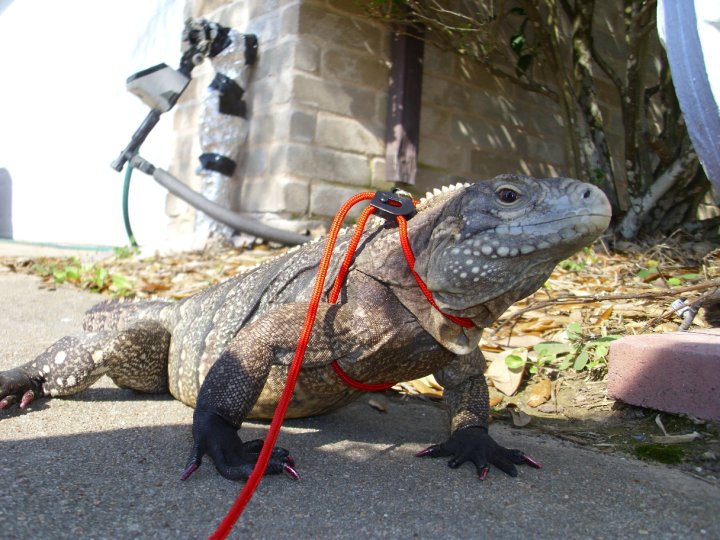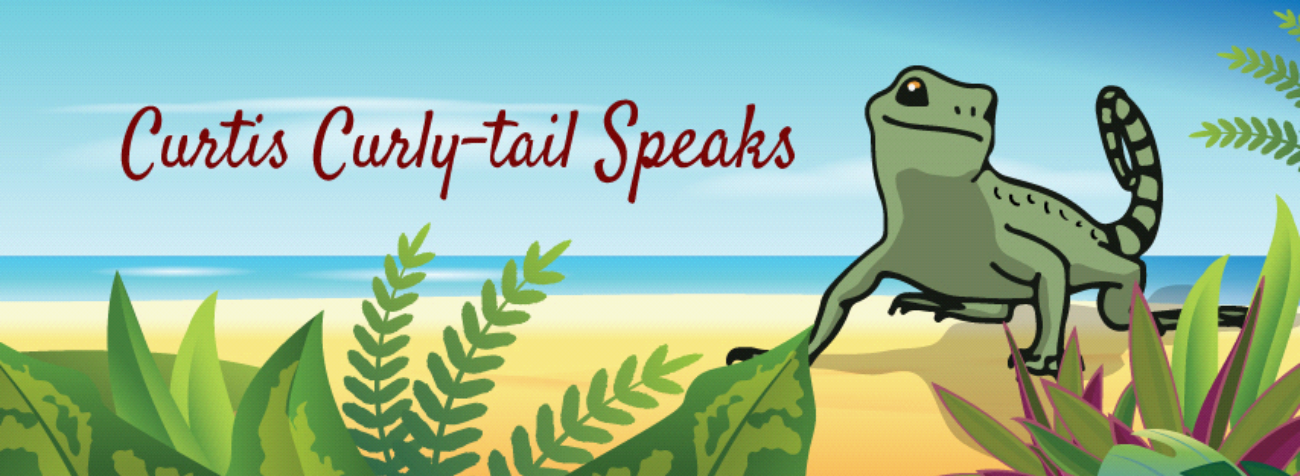It was Kismet! by Susan Glynn Mulé, Author

Hello, everyone! I’ve never actually written a blog post before, so please bear with me. It is a rainy Sunday morning as I sit typing and the atmosphere has everyone around here, mammals and reptiles, sluggish and sleepy. There is a new reptile in the house and her presence has me reflecting, as I often do, on my favorite reptile of all time.
It was spring 2004 and my telephone rang. The caller was an officer of the Louisiana Gulf Coast Herpetological Society. “Hey, Susan, you have experience with big lizards. We have a rock iguana that kinda looks like a big fence lizard. It’s mean and as aggressive as heck. We need a home for it.”
I hesitated a moment, “Mean as heck” worrying me a bit. I had experience with green iguanas but didn’t even know what a rock iguana was. At the time, however, I was co-owner of a company called Suburban Safari. My partner and I gave educational presentations about various domestic and exotic creatures and we had been looking for new education-animals. I spoke before I had time to think it through. “Sure, I’ll take it.”
It was in that serendipitous moment that Kismet Ramoth Mulé entered my life and wormed her way into my heart. From the Herp Society’s description, I was expecting a much larger beast than the 18-inch nose-to-tail baby that arrived at my home; and it did not take me long to realize that the animal was neither mean nor aggressive–just scared. The woman who had relinquished her to the Herp Society included paperwork from Kismet’s breeder, so I soon learned she was a hybrid, a mix of Cyclura lewisi, Cyclura nubile, and Cyclura n. caymanesis. Having a weakness for hybrids of any kind (probably stemming from my childhood crush on Mr. Spock, the Vulcan/human hybrid from Star Trek), I immediately loved her and within a short few months she could be held, albeit with caution.
One lovely autumn afternoon, I put Kismet in her outside sunning cage. Fall in Southeast Louisiana can range from 90-degree days to 40-degree nights, sometimes within the same 24-hour period. When I went outside to retrieve her, I found her sunning cage open . . . and empty. Panic struck my heart. We’d made so much progress. At just two-years-old, Kismet was only two-feet long and her brown and gray coloration was going to make it difficult to spot her among the dead leaves that littered the service alleys behind the neighborhood houses, or in the front gardens lined with mulch.

I went straight to the computer to make flyers while my husband and daughter started the process of knocking on doors, asking people to search their yards. But when night came, her cage remained empty. I prayed and cried until I had no more tears and fell into a restless sleep. The next day brought more of the same. Although we received reports of a giant lizard in various neighbor’s yards, she was always gone by the time we arrived. She seemed to be circling the house and that made us wonder if she was trying to find her way back to warmth and food. We put the parrot outside hoping his calls and cries would lead her home, but to no avail. That night, cooler weather moved in, bringing a raging thunderstorm, and my heart felt like it would break with worry. More prayers and more tears filled the hours until dawn when it was light enough to look again.
By the third day, the weather had mostly cleared and it had warmed up a bit when the doorbell rang. It was a man the next-door neighbor had hired to do some yard work. He’d heard we were looking for a giant lizard (her size becoming more and more exaggerated as the days passed) and there was “a big thing that looked like an alligator on the neighbor’s driveway.” The man was too scared to try and catch it but wondered if it could be ours.
Kismet was hunched in the neighbor’s driveway when we arrived. We were cautiously moving toward the frightened lizard when my neighbor came out of her house, screaming, “I can’t believe that thing is on my driveway!” Kismet bolted, but somehow my husband managed to dive onto the concrete and grab her. He handed the squirming, gaping lizard to me. I took her into my arms and felt her entire body relax. She snuggled her face against my neck and I held her and cried, but this time with tears of profound relief and quiet joy.
The bond that forged between us on the day of her rescue proved solid and only continued to grow. Never in my life had I known such an intelligent and perceptive reptile. Her personality was so completely different from that of my green iguana, Mayan. Kismet was almost dog-like in her interaction with our family.
At the end of summer 2005, we evacuated from our home for Hurricane Katrina and after finding it was destroyed by flood waters, we resettled in Texas. The East Texas Herpetological Society helped us find caging and a good reptile vet.
Kismet continued to grow, as did our bond.
TO BE CONTINUED
Susan Glynn Mulé is the author of Princess Tien: A Mountain Horned Dragon Tale.
To learn about our latest science-based children’s books and workbooks, to read our latest blog posts about reptiles, birds, cats, and gardening, in a variety of locations, and about how the books come to be, what inspires an author to write, and many more interesting aspects of the publishing business, fill in the box below and we will add you to our email list.
Thank you!



